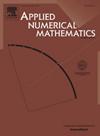Splitting techniques for DAEs with port-Hamiltonian applications
IF 2.4
2区 数学
Q1 MATHEMATICS, APPLIED
引用次数: 0
Abstract
In the simulation of differential-algebraic equations (DAEs), it is essential to employ numerical schemes that take into account the inherent structure and maintain explicit or hidden algebraic constraints. This paper focuses on operator splitting techniques for coupled systems and aims at preserving the structure in the port-Hamiltonian framework. The study explores two decomposition strategies: one considering the underlying coupled subsystem structure and the other addressing energy-associated properties such as conservation and dissipation. We show that for coupled index-1 DAEs with and without private index-2 variables, the splitting schemes on top of a dimension-reducing decomposition achieve the same convergence rate as in the case of ordinary differential equations. Additionally, we discuss an energy-associated decomposition for linear time-invariant port-Hamiltonian index-1 DAEs and introduce generalized Cayley transforms to uphold energy conservation. The effectiveness of both strategies is evaluated using port-Hamiltonian benchmark examples from electric circuits.
带有端口-哈密顿应用程序的dae拆分技术
在微分代数方程(DAEs)的模拟中,必须采用考虑其固有结构并保持显式或隐式代数约束的数值格式。本文重点研究了耦合系统的算子分裂技术,目的是在端口-哈密顿框架中保持结构。该研究探讨了两种分解策略:一种考虑底层耦合子系统结构,另一种考虑与能量相关的特性,如守恒和耗散。我们证明了对于有或没有私有指标2变量的耦合指标1 DAEs,在降维分解之上的分裂方案与常微分方程的情况下具有相同的收敛速度。此外,我们讨论了线性时不变端口-哈密顿指数-1 DAEs的能量相关分解,并引入广义Cayley变换以保持能量守恒。利用电路中的端口-哈密顿基准算例对两种策略的有效性进行了评估。
本文章由计算机程序翻译,如有差异,请以英文原文为准。
求助全文
约1分钟内获得全文
求助全文
来源期刊

Applied Numerical Mathematics
数学-应用数学
CiteScore
5.60
自引率
7.10%
发文量
225
审稿时长
7.2 months
期刊介绍:
The purpose of the journal is to provide a forum for the publication of high quality research and tutorial papers in computational mathematics. In addition to the traditional issues and problems in numerical analysis, the journal also publishes papers describing relevant applications in such fields as physics, fluid dynamics, engineering and other branches of applied science with a computational mathematics component. The journal strives to be flexible in the type of papers it publishes and their format. Equally desirable are:
(i) Full papers, which should be complete and relatively self-contained original contributions with an introduction that can be understood by the broad computational mathematics community. Both rigorous and heuristic styles are acceptable. Of particular interest are papers about new areas of research, in which other than strictly mathematical arguments may be important in establishing a basis for further developments.
(ii) Tutorial review papers, covering some of the important issues in Numerical Mathematics, Scientific Computing and their Applications. The journal will occasionally publish contributions which are larger than the usual format for regular papers.
(iii) Short notes, which present specific new results and techniques in a brief communication.
 求助内容:
求助内容: 应助结果提醒方式:
应助结果提醒方式:


